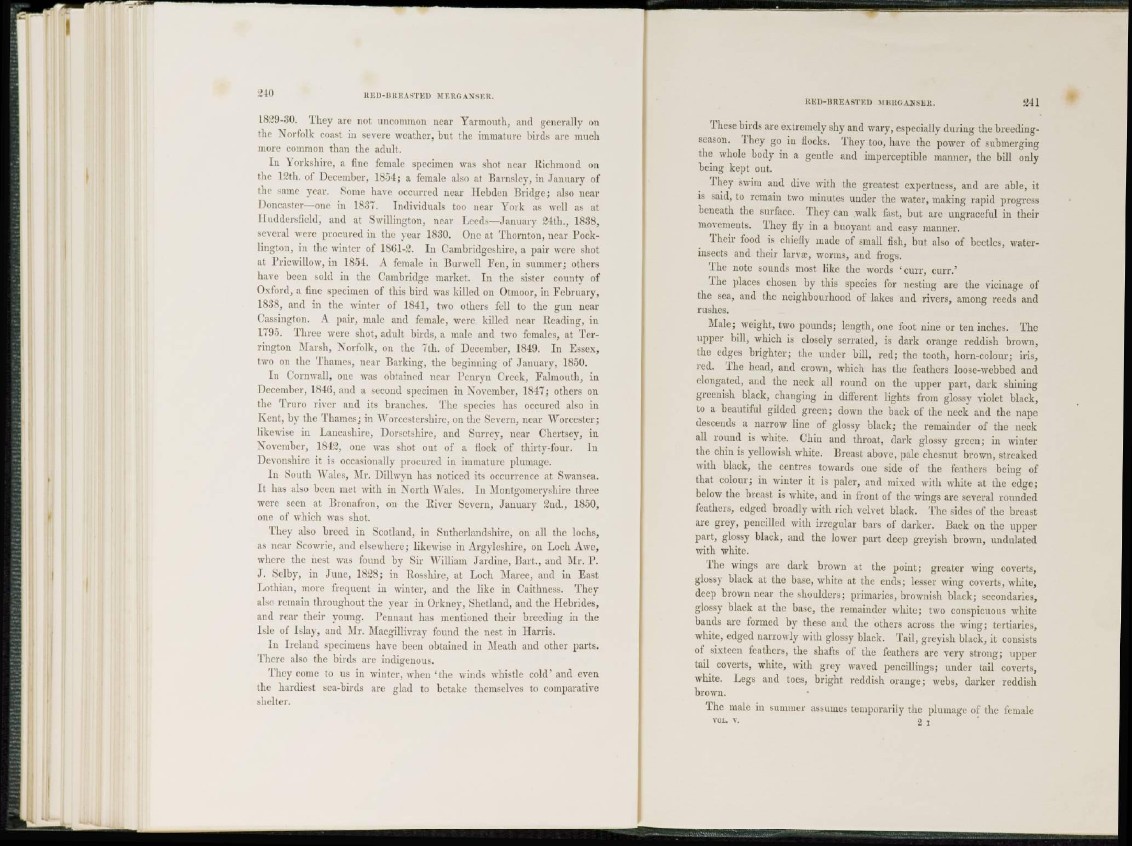
R ED-B11K A ST E 1> MERGANSER.
1829-30. They are not uncommon near Yarmouth, and generally on
the Norfolk coast in severe weather, but the immature birds arc much
mure common than the adult.
In Yorkshire, a fine female specimen was shot near Richmond on
the 12th. of December, 1854; a female also at Barnsley, in .January of
the same year. Some have occurred near Itebdcn Bridge; also near
Doncastcr—one in 1837. Individuals too near York as well as at
lluddersfield, and at SwiLUngton, near L e e d s — J a n u a r y 24th., 1838,
several were procured in the year 1830. One at Thornton, near Pocklington,
in the winter of 1861-2. In Cambridgeshire, a pair were shot
at Pricwillow, in 1854. A female in Burwcll Pen, in summer; others
have been sold in the Cambridge market. In the sister county of
Oxford, a fine specimen of this bird was killed on Otmoor, in February,
1838, and in the winter of 1841, two others fell to the gun near
Cassington. A pair, male and female, were killed near Reading, in
1795. Three were shot, adult birds, a male and two females, at Terrington
Marsh, Norfolk, on the 7th. of December, 1849. In Essex,
two on the Thames, near Barking, the beginning of January, 1850.
I n (lornwall, one was obtained near Penryn Creek, Falmouth, in
December, 1846, and a second specimen in November, 1847; others on
the Truro river and its branches. The species has occured also in
Kent, by the Thames; in Worcestershire, on the Severn, near Worcester;
likewise in Lancashire, Dorsetshire, and Surrey, near Chertsey, in
November, 1842, one was shot out of a flock of thirty-four. In
Devonshire it is occasionally procured in immature plumage.
I n South Wales, Mr. Dillwyn has noticed its occurrence at Swansea.
I t has also been met with in North Wales. In Montgomeryshire three
were seen at Bronafron, on the River Severn, January 2nd., 1850,
one of which was shot.
They also breed in Scotland, in Sutherlandshire, on all the lochs,
as near Scowrie, and elsewhere; likewise in Argylcshire, on Loth Awe,
where the nest was found by Sir William Jardine, Bart., and Mr. P.
J. Sclby, in June, 1828; in Rosshirc, at Loch Maree, and in East
Lothian, more frequent in winter, and the like in Caithness. They
alsi remain throughout the year in Orkney, Shetland, and the Hebrides,
and rear their young. Pennant has mentioned their breeding in the
Isle of Islay, and Mr. Macgillivray found the nest in Harris.
I n Ireland specimeus have been obtained in Meath and other parts.
There also the birds are indigenous.
They come to us in winter, when ' t h e winds whistle cold' and even
the hardiest sea-birds are glad to betake themselves to comparative
shelter.
These birds are extremely shy and wary, especially during the breedingseason.
They go in flocks. They too, have the power of submerging
the whole body in a gentle and imperceptible manner, the bill only
being kept out.
They swim and dive with the greatest expertness, and arc able, it
is said, to remain two minutes under the water, making rapid progress
beneath the surface. They can walk fast, but are ungraceful in their
movements. They fly in a buoyant and easy manner.
Their food is chiefly made of small fish, but also of beetles, waterinsects
and their larva?, worms, and frogs.
The note sounds most like the words ' c u r r , curr.'
The places chosen by this species for nesting are the vicinage of
the sea, and the neighbourhood of lakes and rivers, among reeds and
rushes.
Male; weight, two pounds; length, one foot nine or ten inches. The
upper bill, which is closely serrated, is dark orange reddish brown,
the edges brighter; the under bdl, red; the tooth, horn-colour; iris,
red. The head, and crown, which has the feathers loose-webbed and
elongated, and the neck all round on the upper part, dark shining
greenish black, changing in different lights from glossy violet black,
to a beautiful gilded green; down the back of the neck and the nape
descends a narrow line of glossy black; the remainder of the neck
all round is white. Chin and throat, dark glossy green; in winter
the chin is yellowish white. Breast above, pale chesnut brown, streaked
with black, the centres towards one side of the feathers being of
that colour; in winter it is paler, and mixed with white at the edge;
below the breast is white, and in front of the wings arc several rounded
feathers, edged broadly with rich velvet black. The sides of the breast
are grey, pencilled with irregular bars of darker. Back on the upper
part, glossy black, and the lower part deep greyish brown, undulated
with white.
The wings arc dark brown at the point; greater whig coverts,
glossy black at the base, white at the ends; lesser wing coverts, white,
deep brown near the shoulders; primaries, brownish black; secondaries,
glossy black at the base, the remainder white; two conspicuous white
bands arc formed by these and the others across the wing; tertiaries,
white, edged narrowly with glossy black. Tail, greyish black, it consists
of sixteen feathers, the shafts of the feathers are very strong; upper
tail coverts, white, with grey waved pencillings; under tail coverts,
white. Legs and toes, bright reddish orange; webs, darker reddish
brown.
The male in summer assumes temporarily the plumage of the female